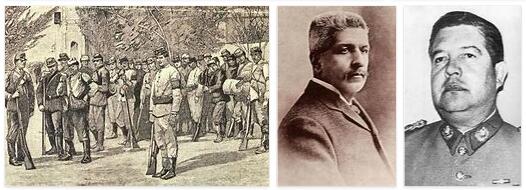With the resignation of Ibáñez, the president of the Senate, Pedro Opazo Letelier, came to power, who appointed radical Juan Esteban Montero as vice president, who ascended to the presidency after the election process carried out on October 4, 1931. The 4 of June of 1932 there was a military uprising led by the Air Force, which led to the resignation of the president and the proclamation of a socialist republic, the power was in charge of a board of integrated government by Arturo Puga, Carlos Dávila and Eugene Matte.
Governing board
The new government captured popular sympathy but within it there was no unity. Dávila resigned from the board and was replaced by Rolando Merino Reyes. Upon separating, he co-formed a new junta led by him, restoring public order, although a regime was established that had no other support than force. A short time later, Dávila dissolved the junta and assumed power with the title of “provisional President”, a power that was later handed over to General Bartolomé Blanche, who had to face strong civic-military pressure clamoring for the return to institutional normality. Blanche resigned on October 2 and handed over power to Chief Justice Abraham Oyanedel, who called for presidential and parliamentary elections for October 30. In these elections, Arturo Alessandri Palma and the parties that supported him triumphed: liberals, democrats and radicals. With these elections anarchy ended and the country was re-directed towards the recovery of institutions.
Three radical governments
Alessandri managed, after a period in which he had to govern with extraordinary powers, to reimpose the constitutional order, and in this he had the collaboration of all political sectors, the same ones that in the last years of his administration, withdrew their support and passed to the opposition. This is how the presidential elections of 1938 were carried out. Pedro Aguirre Cerda was the Popular Front candidate who won the election and his government carried out an ambitious education plan, which led to the creation of more than a thousand primary schools and some 3,000 positions for teachers. However, he did not manage to finish his six-year term, death surprised him, on November 25, 1941.
Two months later, the radical Juan Antonio Ríos was elected as the new ruler, who tried to create a national government that would not bow to the demands of the different political parties. This president, neither could he finish his term, he died on June 27, 1946. In his place, Gabriel González Videla was elected in September 1946, who issued the Law for the Permanent Defense of Democracy, promulgated in 1948. Its application implied that the Communist Party was condemned and that its top leaders were imprisoned in Pisagua while other prominent militants, including the poet Pablo Neruda, had to flee the country. During Videla’s mandate, the Concón Oil Refinery and the Paipote Smelter were built, the latter intended to promote the development of the small and medium-sized mining industry in Norte Chico. It was also promulgated the Law No. 9,292, the 8 as January as 1949, which granted the right to vote to women in presidential elections. In 1952 after elections Carlos Ibañes returned to the presidency.
In the second government of Ibáñez, the merger of different credit and savings institutions in the State Bank was carried out in 1953, the Ministry of Mining was created, due to the economic importance that this activity represented for the country, the Institute of Insurance of the State (ISE), the Housing Corporation (Corvi) and the Superintendency of Education. The Electoral System was reformed, which meant the establishment of a single ballot, printed and distributed by the Electoral Registry.
In the 1958 elections, Jorge Alessandri Rodríguez came to power, his government stood out, mainly, in the construction of houses, which exceeded 150,000 units, covering 80 percent of the population growth; the construction of numerous paved roads, irrigation canals, hospitals and schools. Mining production experienced a notable increase. He promulgated, in 1962, Law 15.020, on Agrarian Reform, but rising inflation was causing social discontent. The 4 as September as 1964 the country re-election and takes office the Christian Democrat Eduardo Frei Montalva who in 1968, enacted the law of Neighborhood Councils, which also legalized mothers’ centers and other community organizations.
During Frei’s tenure, the unions increased the number of members, from about 270,000 in 1964 to around 500,000 in 1970. He was the promoter of the Chileanization of copper, a process known as one of his great achievements by showing positive results. He also undertook a vast plan in favor of education. In the vicinity of the 1970 presidential election, the left-wing opposition united to form the Popular Unity and appointed Salvador Allende Gossens as its candidate.
He led a campaign founded on a program that promised the nationalization of all grassroots industries, banks, and communications. On September 4, the country returns to the elections, and on October 24 Salvador Allende ascends to the presidency, on November 4, he was sworn in as the first democratically elected Marxist president in the world. He received not only about 37% of the votes, but also the unconditional support of Congress in the face of his right-wing adversary, former President Alessandri. Allende was then the first president elected under a socialist program in a non-communist country.
